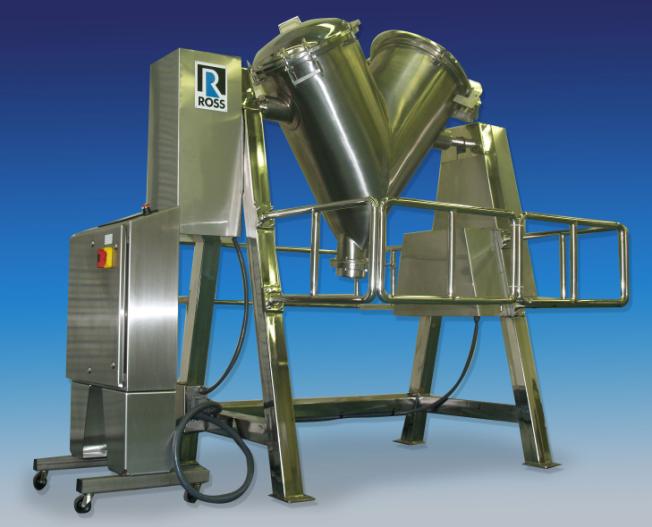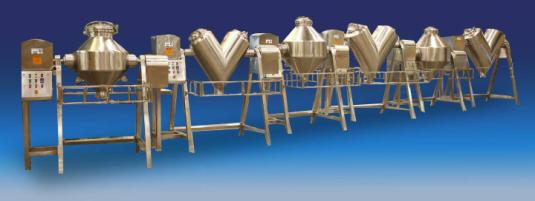Tech Report
Specifying a tumble blender for pharmaceutical manufacturing

Technology Brief
Tumble blenders deliver highly accurate and repeatable mixing of powders, granules and even low-viscosity slurries. In addition, this style blender enables complete discharge and easy cleaning. This bulletin presents some design considerations for maximizing mixing efficiency in a tumble blender and selecting the most suitable features for a particular application.
Benefits of tumble blending
A tumble blender is a rotating device that comes in a variety of geometries, the most common being the symmetrical V-shaped or double-cone configurations. The vessel is partially loaded with product and rotated at operating speeds in the range of 5 to 25 revolutions per minute. Diffusion is the main mechanism for mixing: batch materials cascade down, distributing particles over a freshly exposed surface as the vessel rotates on a horizontal axis.
One main advantage to tumble blending is that it is very low-impact. This enables it to thoroughly mix highly friable materials without compromising their integrity or generating excessive amounts of fines. Its widespread use in the pharmaceutical industry is due to its proven capability of making precise blends that contain minor and trace components (i.e. active ingredients <1%) or ingredients that are vastly dissimilar in size and density. When designed properly, the tumble blender can handle not only dry solid blends such as powders and granules but also low-viscosity slurry-type mixtures.
Another benefit comes from the geometry of the V-shaped and double-cone vessels which allows complete discharge of the blended material. The tumble blender is also easily accessible for cleaning. A smooth finish or mirror polish on all product-contacting surfaces further improves cleanability and sanitation.
Specify your perfect tumble blender
Below are some considerations for specifying the tumble blender that will best suit your particular process.
- Proper sizing. The desired batch volume (not mass) determines the size of the tumble blender but bulk density determines motor horsepower and if a standard or heavy-duty model is required. Make sure to provide your blender supplier with accurate product density data for all formulations that you are looking to process in the same tumble blender.
- Reduction of lumps. The gentle blending action of the rotating vessel is not suitable for breaking down tough lumps in the batch. A high speed intensifier bar is required for applications that need sufficient shear to reduce the size of agglomerates. This intensifier bar is installed along the blender`s axis of rotation.
- Solid/liquid mixing. If the liquid phase is a minor ingredient in the blend, it can be continuously sprayed across the solids as the blender is rotating. To accomplish this, spray nozzles are installed on the high speed intensifier bar designed for liquid addition. For low-viscosity slurry-type applications, all solid and liquid components may be charged through the vessel cover at the beginning of the blend cycle.
- Drying requirements. Drying applications often benefit from having a jacketed vessel that is also rated for vacuum. Vacuum drying is an excellent method for drying heat-sensitive products because it requires lower heat to drive off moisture or solvents compared to drying under atmospheric conditions.
- Controls. The most basic controls allow you to start, stop and jog the motor. However, a variable frequency drive is typically recommended as it allows soft start under full load conditions. It also enables adjustment of rotation speed so that the contents can slide or cascade to the lower portion of the rotating vessel at a controlled rate. To establish a highly repeatable mixing cycle for a particular formulation, the blender can be programmed to rotate at a set speed and shut off automatically after a certain number of revolutions. Sophisticated PLC systems can be integrated to program multiple steps and recipes in more demanding processes.
Sample Application: Generic Drugs

At a large pharmaceutical plant, numerous Ross Sanitary Tumble Blenders are being used to prepare homogenous powder and granular blends for generic drugs.